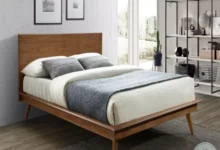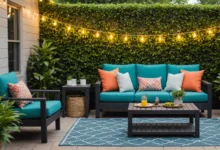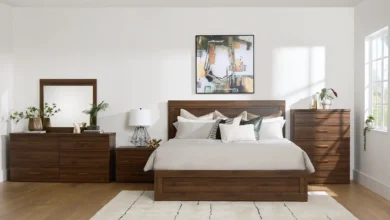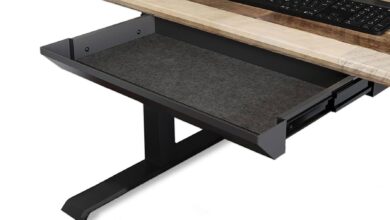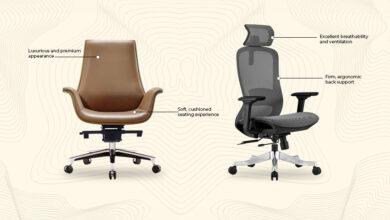Maximize Your Space: Clever Storage Closet Solutions
A storage closet, often relegated to the dusty corners of our homes, can surprisingly transform from a forgotten space into a haven of organization. It’s a place where forgotten treasures, seasonal items, and those “maybe-one-day” projects can find a peaceful resting place, freeing up valuable space in your main living areas and allowing you to reclaim your home for actual living, not just storage.
Contents
- 1 Choosing the Right Storage Closet Size and Location
- 2 Building Your Storage Closet: Materials and Construction
- 3 Interior Organization: Shelves, Drawers, and Other Essentials
- 4 Maximizing Vertical Space
- 5 Choosing the Right Closet Doors
- 6 Lighting and Ventilation
- 7 Color Schemes and Décor
- 8 Storage Solutions for Specific Needs
- 9 Safety and Security Considerations
- 10 Maintenance and Cleaning
- 11 Maximizing Space: Clever Storage Closet Organization Ideas
- 12 Vertical Storage Solutions: Utilizing Every Inch
- 13 The Power of Shelving: Strategically Positioning Your Storage
- 14 Clever Container Strategies: Maintaining Order
- 15 The Art of Grouping Similar Items: Making Sense of the Mess
- 16 Drawer Solutions: For Smaller Items
- 17 Hanging Solutions for Clothes and Accessories: Saving Space
- 18 Lighting and Ventilation: Encouraging a Pristine Space
- 19 Color-Coding and Labeling: Enhancing Visual Organization
- 20 Regular Maintenance: Keeping Your Closet Organized
- 21 Maximizing Space: Clever Storage Solutions for Your Closet
- 22 Utilizing Vertical Space: Stacking and Shelving Strategies
- 23 Clever Organization with Baskets and Bins
- 24 Incorporating Drawers and Dividers
- 25 Customizable Solutions for Specific Needs
- 26 The Power of Labels and Color Coding
- 27 Well, That’s a Wrap!
Choosing the Right Storage Closet Size and Location
Deciding on the ideal size and location for your storage closet is crucial for maximizing its usefulness. Don’t just slap a closet in any old corner; consider how much space you truly need and where it’ll be most accessible and practical. A well-placed storage closet will become an indispensable part of your home’s organization, not just a forgotten space stuffed with clutter. Think about what you’ll be storing—seasonal clothing, holiday decorations, extra linens, sporting equipment, or maybe even those bulky boxes overflowing with cherished memories. A larger closet might seem tempting, but it’s a waste of space and resources if it’s not the appropriate size. A small, strategically placed closet could work just as well. The goal is efficiency. Measure the items you intend to store, and add some extra space to account for potential future acquisitions. Consider the accessibility aspect too. If you’re storing frequently used items, a closet located near the entryway or laundry room could save you a lot of time and effort. This placement is also important if the closet is designated for outdoor gear or sports equipment—make sure it’s near where those items are used or stored.
Building Your Storage Closet: Materials and Construction
Constructing a storage closet, whether it’s a new addition or a renovation of an existing space, requires careful consideration of materials and construction methods. You want something sturdy, durable, and aesthetically pleasing—and it should last! The construction will dictate how much storage you can achieve and the durability of your closet. Wood, laminate, or metal frames provide sturdy bases, but bear in mind that metal may not always blend seamlessly into your home’s décor. Wood offers a natural warmth and can be stained or painted to match your existing style. Laminate is a practical choice, offering good resistance to damage and moisture and often a lower cost than wood. Consider the thickness and quality of the materials you choose, as this directly impacts the lifespan of your closet. Don’t underestimate the importance of proper wall framing, support beams, and anchoring systems. Hiring a professional contractor can be a great way to ensure the structural integrity and longevity of your closet. They can advise on the best materials for your specific needs and ensure everything is securely fastened and structurally sound, saving you potential headaches and repair costs down the road.
Interior Organization: Shelves, Drawers, and Other Essentials
Organizing the interior of your storage closet is where the real magic happens. A well-organized storage space will not only look good, but it will also make your life so much easier. The key is to plan ahead and make use of various storage solutions. Start by deciding what kinds of storage items you need. Adjustable shelving units are incredibly versatile and allow you to store items of varying heights and widths. Built-in drawers are excellent for storing smaller items or frequently used items. Consider hanging shoe racks or dividers for organizing shoes or clothing. Don’t overlook the power of bins and containers – plastic or fabric bins with lids are fantastic for storing seasonal items or organizing small objects. This helps you maintain a clean and organized look within the closet. If the storage includes clothing, consider installing a hanging rod to maximize space for shirts, jackets, and pants. Label everything clearly, whether it’s a shelf, a drawer, or a container. This labeling will help you find what you need quickly and easily. This will be crucial for retrieving items when needed without the frustration of searching through chaos.
Maximizing Vertical Space
Vertical storage is often overlooked, but it’s a game-changer for maximizing space in a storage closet. Consider using tall shelving units that reach from floor to ceiling. This can dramatically increase the capacity of your closet, allowing you to store a significant amount of items without compromising the overall appearance of the space. These tall shelves work incredibly well for storing bulky items like blankets, boxes, or seasonal décor that you don’t use every day. Think about installing shelves at varying heights; some taller shelves and some shorter shelves, depending on the needs of the items you’ll be putting away. This allows you to tailor your storage to each item’s size and shape. If you’re maximizing vertical space for clothing, consider multi-tiered hanging organizers that can hold multiple items on one rod. A well-thought-out vertical storage system means less wasted space and a more organized and usable storage closet.
Choosing the Right Closet Doors
The choice of closet doors is an important aesthetic and functional consideration. Many options are available, from simple and functional to sophisticated and stylish. Sliding doors are a popular choice, particularly for smaller closets, as they save space and create a smooth, uninterrupted flow within the room. Swinging doors are another option, offering a classic look, but potentially taking up a little more space. Consider the style of your home when choosing the door style. If your home boasts a modern aesthetic, sliding doors might be the way to go, while a more traditional style could benefit from swinging doors. The type of material used for the doors can also affect the design. Solid wood doors create a classic look, while mirrored or glass doors can add a touch of elegance and reflection to the space. Consider the materials carefully as some materials may be more prone to damage compared to others.
Lighting and Ventilation
Adequate lighting and ventilation are crucial for both the functionality and the longevity of your storage closet. Poor lighting can make it difficult to locate items, while insufficient ventilation can contribute to moisture and mildew issues. Installing recessed lighting or strategically placed LED strips within the storage closet can dramatically improve visibility, making it easy to find what you’re looking for. This also helps in making the storage area safer and more functional. If possible, add a small vent to the closet to allow for air circulation and help prevent moisture buildup. This is particularly important if you’re storing items that are susceptible to moisture damage or if the closet is in an area that tends to be damp. Adequate lighting and ventilation make your closet safer and more useful, ensuring that its contents stay in good condition for a long time.
Color Schemes and Décor
Don’t underestimate the impact of color and décor in creating a functional and visually appealing storage closet. The color scheme can significantly affect the mood and atmosphere of the space, making it feel more welcoming and organized. Painting the walls a neutral color, such as beige or gray, creates a backdrop that works well with various storage solutions. You can also add some subtle accents through decorative items to make the area more pleasing. Storage bins in coordinating colors add a touch of style, while strategically placed mirrors can make the space feel larger and brighter. If you have the room, a small rug can help ground the area. The goal here is to create a space that feels organized and aesthetically pleasing, blending seamlessly into the rest of the home.
Storage Solutions for Specific Needs
Every home has its own unique storage needs. If you’re a homeowner with a family or have hobbies, you might require specialized solutions. For example, a designated storage area for children’s toys could use stackable shelves and bins to keep everything tidy. For a hobbyist, maybe a storage system for art supplies is the key. Specialized shelving and drawer systems can help accommodate these specific needs. Clothes storage might necessitate hanging rods, drawers, and folding storage boxes. You might consider dedicated shoe organizers or hat racks if you have a large collection of shoes or hats. The trick is to customize your storage solutions to meet the unique demands of your household and lifestyle. This ensures that each item has its place and that the entire space works efficiently for your needs.
Safety and Security Considerations
Finally, remember that your storage closet should also be safe and secure. This includes considering the placement of items and potentially securing access to the closet. If the closet holds potentially hazardous items like cleaning supplies or chemicals, make sure they’re stored securely in closed containers and away from direct sunlight or extreme temperatures. Secure and clearly marked storage solutions help prevent accidental mishaps or injuries. If the closet is in a high-traffic area, consider installing a childproof lock to prevent accidental entry by young children. For the protection of your belongings, particularly valuable items, ensure that the closet doors are strong enough to deter potential theft. Think carefully about security measures to ensure that your valuable items are protected. These thoughtful measures create a safe and secure storage environment within your home.
Maintenance and Cleaning
Regular maintenance and cleaning are essential for the longevity and effectiveness of your storage closet. Dusting shelves, vacuuming floors, and wiping down surfaces should be part of your routine. This will help to maintain the cleanliness and organization of your space, and keep your items in pristine condition. Regularly inspecting your storage system will reveal any issues or potential problems early on. Cleaning out any excess dust and dirt will help preserve the life and maintain the quality of your valuable stored items, whether it be clothing or other items. Make sure to thoroughly check for any signs of damage to the shelving units or storage containers to ensure they are safe for continued use. Proper maintenance is an investment in the long-term success and effectiveness of your storage closet.
Maximizing Space: Clever Storage Closet Organization Ideas
Storage closets, often overlooked, are surprisingly powerful spaces for maximizing your home’s organization. The key is to think outside the box – literally! Instead of just shoving stuff in, consider clever strategies to transform your storage closet into a functional and aesthetically pleasing haven. This isn’t about minimalist perfection; it’s about creating a system that works for *you*. Imagine walking into a closet and feeling a sense of calm, knowing exactly where everything is. That’s the power of a well-organized storage closet. Start by clearing out anything you haven’t used in the past year. Donate, recycle, or toss – you’ll be amazed at how much space you gain just by letting go of the unnecessary.
Vertical Storage Solutions: Utilizing Every Inch
Vertical storage is your friend when dealing with a smaller storage closet. Instead of placing items flat on shelves, consider using stackable bins, shelves that extend from the floor to the ceiling, or even tall, slender storage units. This not only maximizes vertical space but also visually streamlines the closet. If you’ve got a lot of seasonal items, consider using stackable plastic containers or hanging shoe organizers to keep items neat and compact. Invest in shelves that are adjustable to accommodate varying storage needs. For example, you might use deeper shelves for bulky items like blankets and shallower shelves for smaller items like hats and scarves. Don’t be afraid to get creative with DIY projects; a little effort here can significantly improve your closet’s capacity.
The Power of Shelving: Strategically Positioning Your Storage
Choosing the right shelves is crucial for a well-organized storage closet. Consider the weight capacity of each shelf. Heavy items like boxes of winter clothing should be stored on lower shelves, while lighter items like shoes and hats can be placed on upper shelves. Look for shelves with open backs to maximize airflow and prevent moisture buildup. A mix of open shelving and closed cabinets is often the best solution; open shelving displays stylish storage while cabinets provide a place to hide items that you might not want to display. Proper spacing between shelves is critical for easy access and prevents clutter. This allows for easy visibility and access to items while maintaining an organized and clean aesthetic within the closet. Ensure that your chosen shelving system comfortably fits your storage needs, providing enough depth and width.
Clever Container Strategies: Maintaining Order
Investing in good quality storage containers is a game-changer for any storage closet. Choose containers that are both stylish and functional. Clear plastic containers are great for showcasing items and easily locating specific items. Label your containers clearly to quickly identify the contents – whether it’s seasonal clothes, holiday decorations, or sports equipment. Labeling makes locating items a breeze, which is essential for maintaining a well-organized space. Use different sized containers to group similar items, making it easy to locate what you need when you need it. For delicate items, invest in specialty storage containers for clothing or accessories.
The Art of Grouping Similar Items: Making Sense of the Mess
Grouping similar items together within the storage closet greatly enhances organization. For example, store seasonal clothes together, keeping summer clothes separated from winter attire. Group decorations by holiday or theme for easy access. This method dramatically reduces the time spent searching for specific items. When you group items together, you streamline access and also make the space look more aesthetically pleasing. Think about creating themed zones within the closet, such as “holiday decor,” “office supplies,” or “outdoors gear.” This structure facilitates easy finding and reduces the feeling of clutter.
Drawer Solutions: For Smaller Items
Drawers are perfect for smaller items like socks, accessories, or craft supplies. Use drawer dividers to keep items neat and prevent them from shifting around. Consider using clear plastic drawers or containers for easy identification and quick access. Invest in high-quality drawer organizers to keep everything in its place, maximizing storage space. This not only maintains order but also makes the items easier to locate.
Hanging Solutions for Clothes and Accessories: Saving Space
Hanging items is a smart way to optimize vertical space and keep clothes and accessories organized. Utilize hanging organizers for accessories or use hanging shoe racks for shoes. This is ideal for storing garments like coats, bags, scarves, and hats. Ensure that the closet hangers are sturdy enough to hold the weight of your items, preventing damage and keeping everything neatly arranged.
Lighting and Ventilation: Encouraging a Pristine Space
Adequate lighting significantly improves your storage closet’s usability. Install bright LED lights to illuminate the space and make it easier to see and locate items. Ventilation prevents moisture buildup, which can damage stored items. A small, strategically placed fan can assist with air circulation, contributing to a clean and healthy environment.
Color-Coding and Labeling: Enhancing Visual Organization
A system of color-coding for similar items makes finding what you need significantly easier. Color-code containers and shelving to instantly identify items. A well-designed system of labels makes locating items effortless. Consider using a combination of labels and color-coding for optimal organization.
Regular Maintenance: Keeping Your Closet Organized
Regular maintenance is key to keeping your storage closet organized. Take time each week or month to declutter, reorganize, and refresh the space. This process prevents clutter from accumulating and ensures that your storage closet remains functional and efficient. A little bit of effort now can prevent a lot of frustration down the line.
Maximizing Space: Clever Storage Solutions for Your Closet
So, you’ve got your storage closet, now what? Turning that potentially dusty, disorganized space into a functional and efficient storage haven requires a bit of planning and some smart solutions. This section dives into some clever tricks to squeeze the most out of your storage closet, making it a true workhorse for your belongings. We’ll explore everything from maximizing vertical space to incorporating creative organizers.
Utilizing Vertical Space: Stacking and Shelving Strategies
Vertical space is often the most overlooked aspect of a closet. Instead of just using the floor for storage, consider how high you can go. Tall shelving units are your best friend here. They can house items like seasonal clothing, off-season shoes, or bulky blankets and linens. Don’t underestimate the power of stackable containers. These are incredibly useful for smaller items like socks, scarves, and jewelry. They keep things organized and prevent them from getting lost in the back of the closet. Consider investing in adjustable shelves; this will allow you to customize the height of your storage based on what you’re storing. For example, if you’re storing heavier items on the lower shelves, you can adjust the height to prevent sagging. Don’t forget the potential of wall-mounted shelves. They can provide additional storage without taking up floor space, especially beneficial for items you don’t use frequently, like decorative items or infrequently-worn clothes. By maximizing vertical space, you drastically improve the overall efficiency of your closet.
Clever Organization with Baskets and Bins
Baskets and bins are your closet’s unsung heroes. They’re perfect for organizing similar items, like towels, or for grouping together various accessories. Choose different sizes and shapes to cater to your needs. A wide, shallow basket can be excellent for storing shoes or scarves, while a tall, narrow container works great for storing blankets or sweaters. Think about using fabric baskets or plastic bins in complementary colors. This creates a visually appealing and organized environment, not just a functional storage area. Labeling your bins can also save you significant time when you need something specific. This is important for not only physical items, but also for the mental organization of your closet. For example, if one basket is for "winter hats," that’s immediately clear to everyone using the closet. Don’t underestimate the power of clear storage bins – these allow you to easily see what’s inside without having to dig through everything.
Incorporating Drawers and Dividers
Drawers and dividers are essential for small items like jewelry, accessories, and small clothing items. Investing in a set of drawers, or repurposing some old ones, allows you to easily categorize and access these often-misplaced items. Dividers within drawers can create little compartments for rings, earrings, necklaces, and bracelets, ensuring that everything stays in its place. This prevents jewelry from getting tangled and damaged, and you can quickly access your favorite pieces. The same principle applies to smaller items like socks or underwear. Dedicated drawers for these prevent them from becoming a tangled mess. Use drawer dividers to create different compartments for different sizes or types of items. For example, you could have separate compartments for men’s socks, women’s socks, or even different sizes of socks within the same drawer. This organization dramatically reduces the time it takes to find what you need.
Customizable Solutions for Specific Needs
Don’t just think about the general stuff; tailor your closet’s organization to your specific needs and the items you frequently store. Maybe you have a lot of shoes. Consider a shoe rack or shoe organizers to maximize space and keep them neat. If you have a lot of handbags, invest in a hanger or rack specifically designed for them. If you’re storing sports equipment, a designated area with appropriate hooks or racks will save you time and energy.
The Power of Labels and Color Coding
This final step might seem small, but it’s crucial. Labeling bins, shelves, and drawers can save you time and reduce frustration. For a quick visual organization aid, try using color-coding. For example, if your bins for all of your "winter items" are a specific shade of gray, you can instantly identify them at a glance. Labels ensure you know exactly what’s contained in each section, making it easier to find what you’re looking for and keeping your closet in good order. Consistent labeling and color coordination also make it easier for other people to use the closet, particularly if you share the space with family members or roommates.
Well, That’s a Wrap!
So, there you have it – a few ideas for taming that storage closet beast. Hopefully, you’ve found something useful here. Thanks for reading! If you’re looking for more organization tips or maybe some home decor inspiration, swing back by sometime. We’ve got more coming soon!

